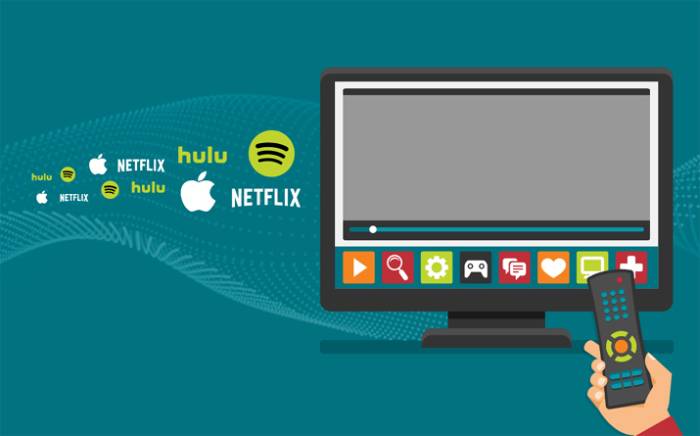So you don’t have to, we have read up on all things OTT and compiled our information in a neat little guide to simplify this mind-boggling concept for you.
Although most of us are now familiar with streaming platforms like YouTube and Netflix, and we have at least an idea of what smart TVs are, the world of OTT still seems like a foreign concept to us. Some of us do not even know what OTT means.
This guide will provide accurate information on what OTT means (in simple English), how it works, and everything else you need to know about this style of advertising.

What is OTT Advertising?
OTT (over-the-top) advertising is content tailored to the consumer’s needs and provided while viewers watch their TV shows on OTT platforms which include smart TVs or connected TVs.
There are multiple ways to access OTT platforms; via your smart TV, mobile devices, computer, tablet, or even gaming console. All you need is an internet subscription and—for streaming services such as Disney+, Netflix, and many others—a monthly or yearly subscription to the OTT platform as well.
Using over-the-top video ads rather than traditional TV advertising allows advertisers and media companies the freedom of sharing their adverts without the limitations that come with geographical limitations or scheduled programs. OTT marketing is so promising that experts have predicted that revenue from OTT adverts will increase to as much as $281.70 billion in 2022. Now is as good a time as any to launch an effective OTT ad.
How is OTT Advertising Delivered?
OTT content is so popular mostly due to its accessibility from a variety of devices. Rather than having a cable dish, a cable box, a subscription to the cable provider, and the whole 9 yards, viewers now need only an active internet subscription and supported smart devices to enjoy their video-on-demand services.
Depending on the streaming platform viewers are using—whether it is Roku, Apple TV, Amazon Fire TV, or something else—the delivery method varies. The process goes like this:
- The target audience for your OTT campaign is selected, and the selection is usually done based on information from the platform or data aggregator. If the audience has submitted more detailed information about their household, the data collected can be even more specific.
- The brand selects a memorable campaign, specifying budget, launch date, and campaign goals.
- The advertising platform will launch the campaign, connecting the audience to a specific TV subscriber list.
- The audience views the ads from OTT devices.
- The advertising agency will receive feedback after running the ad on how successful the advertising campaign was.
Benefits of OTT Advertising
Of course, one of the biggest appeals of OTT advertising is that viewers enjoying video services on OTT devices can’t close the ads, block them, or skip through them the way they would with traditional TV advertising.
Consumers love OTT advertising platforms because they can finally pay for video on demand that is only relevant to them, and also enjoy original content with relevant commercial breaks. Advertisers, on the other hand, love OTT devices for the revenue potential they allow. In addition to a wide variety of premium channels for users, OTT also offers;
-
Targeted Marketing
With OTT marketing, there is little risk of running ads not suited for an audience, because brands have more data on the customer—what they like, geographic location, age, etc. With OTT, brands can also be more certain of reaching and serving their target demographic in harder-to-reach locations.
-
No Escape Advertising
This digital campaign strategy has completely revolutionized the ad experience for consumers, brands, and media houses. In the past, viewers would change the channel and surf through other shows while the morning show ran its video advertising, or fast forward through the 15 and 30-second ad spots on a DVR. But with OTT content, viewers can’t skip the adverts and are instead shown a countdown clock detailing how long the commercial will air.
While the experience is relatively more trapping, there is a better feeling that comes with knowing exactly how long your ad break will last, while brands can also be certain their advertisements are seen.
-
Advanced Analytics
OTT platforms send detailed reports on ads and the audience, allowing advertisers to know which ads are doing well, and which ones need higher optimization. The data obtained also allows advertisers to plan a more accurate advertising strategy in the future, based on their target audience.
Challenges of OTT Advertising
Seeing as it solves many of the problems regular advertising faces, OTT sounds like the perfect advertising option to many. However, just like almost everything else, OTT needs to resolve some of these challenges before we can finally crown it the king of digital advertising.
-
Online Limitation
Perhaps the biggest challenge that comes with OTT advertising is that streaming platforms can only be accessed when you have a high-speed internet connection. Once there is no internet access, viewers cannot enjoy their favorite shows, and therefore there is no opportunity to advertise.
-
Limited TV Content
There is still a large group of people who prefer to watch their live TV, such as news broadcasts and sporting events, through cable. This means that audiences who consume this type of content are largely unreachable. But this trend is shifting rapidly.
-
High Expectations
This poses an issue when companies record massive sales after OTT operations, but other investors do not perform adequate research before investing in OTT ads. Also, video streaming companies constantly see shifts in their number of active users which may cause unexpected performance shifts in the market.
With all of that said, the pros far outweigh the cons. OTT has disrupted the television industry for good; things will never really go back to what they used to be. As viewers turn more to streaming services like Netflix and ad-supported services like Hulu and Roku, traditional TV continues to lose its audience.
And as OTT viewership rises, it is a call to brands to take full advantage of OTT advertising in boosting sales, generating demand, and maximizing the effectiveness of TV campaigns.







































